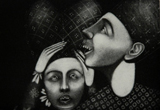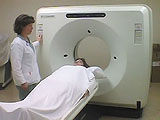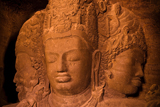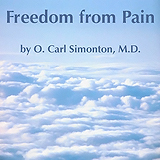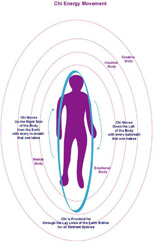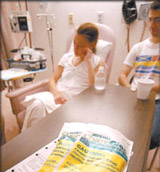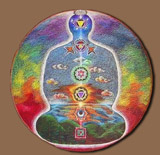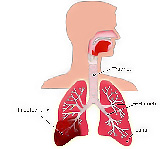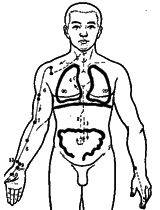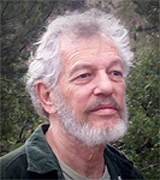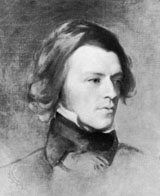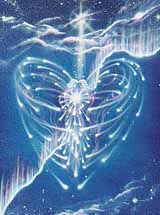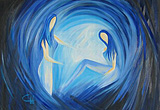Alchemy of the soul
The suffocated soul
Editor's note
This is the sixth chapter of Dr. Arya Maloney's series on the way the soul responds to suffering. He discusses time and again how different therapies help reveal the soul. This article discusses the journey of a woman who had terminal lung cancer.9:15pm, August 12, 2000. The phone rings. I know instantly that it is the call I have been expecting for three days. I hear Steven’s voice,
“Carrie just left her body. I am holding her and I know she hears us.”
Feelings of relief and loss sweep through me. Relief, because the suffering is over, her incredible journey is complete. Loss, because of the pain of separation: in pursuit of her soul, Carrie and I had achieved a rare intimacy.
Five years before, a clinical psychologist called, requesting that I work with Carrie, “She has lung cancer. I don’t know how to help.” Within a few days, Carrie walked into my office.
Coiffed in a brightly colored scarf, a small, intense woman in her mid-thirties entered my office. Her eyes betrayed fear and apprehension, but her movements conveyed courage. Seating herself quickly, she welcomed me into her world of pain and fear. Our first task was to clear any debris from the relationship with her previous therapist.
Diagnosed with lung cancer, Carrie had had two operations on her right lung. In the second operation, doctors removed the lung, but discovered cancer in the remaining one. They pronounced her terminally ill — stage four cancer. She was devastated. Why must she die at such a young age? How could she face separation from her two-year-old daughter? Long repressed emotions poured forth. She decided to see a therapist. Both therapist and husband relayed the same message: “Think positively. Don’t cry.” This was a message she had heard since childhood: the family’s emotional taboo had surfaced again. After her diagnosis, Carrie, her mother and sister, were all crying when her father entered the room. “Stop!” he commanded.
Resurrecting long-buried emotions were to become a major part of my work with Carrie. On July 7, 1994, Carrie heard her death knell, “You have cancer.” In her first surgery, doctors removed the middle lobe of her right lung. Though she was told that the surgery was successful, Carrie lived in fear and agonizing pain for months. During this period, she visited the psychotherapist who told her to think positively.
Three months after surgery, cancer reappeared on the CT scans. The doctors decided that the rest of the right lung had to be removed, followed by four to six cycles of chemotherapy. This diagnosis generated suicidal feelings in Carrie, but because of her two-year-old daughter and her strong will to live, she consented. Subsequent to the surgery, most of the lung was found to be healthy, but several cancerous spots persisted.
After only three cycles of chemotherapy, CT scans were advised again. The cancer now appeared in her left lung — stage four, incurable and terminal. Her expected life span was six months. Still, Carrie did not give up. “Okay”, she said to herself, “I am going to die. Now I need to learn how to live.” It was during chemotherapy that Carrie’s search for alternative therapies began. After nine months, she refused chemotherapy. One and a half years after being diagnosed, she refused all conventional medicine.
Carrie entered my life with her dreams. Never had she paid attention to her dream-life: she had no spiritual orientation. Scientific, with a PhD in biology, ideas of soul, inner being or the significance of dreams, were strange to her. The first dream, experienced one month after diagnosis of incurable cancer, served as a blueprint for our ensuing exploration:
“About 1 a.m. I was awakened by a powerful dream. I arose, confused about what was reality and what was dream.”
Here is the dream:
“I am home waiting for someone I call an ‘adviser’. I am sitting at the kitchen table talking to a friend. I tell this person that Steven (husband) and I are going to take a trip around the world. I don’t know where we are going, but we will make a lot of stops.
The adviser comes to my front door. I intend to tell him about my recurrent dream, but first I must wait for a young woman who was there before me. When it is my turn, I tell him the dream.
In these recurrent dreams I always have a mouth full of ‘stuff’ — either a gummy substance or wads of paper towels. Although the details of the dream differ slightly, the common theme is about the existence of large amounts of stuff in my mouth, and my struggle to remove them. Even when I managed to remove some, more would immediately accumulate. I couldn’t talk and no one in my dreams could hear me. No one noticed my struggle.
I told the adviser that I had dreamt this many times in my life, and could he tell me its meaning. He responded very calmly, ‘You have to find the Hindu and ask him.’ Furious at his ambiguous response I cried, ‘I have no idea what you are talking about!’ Sensing that he was giving me critical information, I was frustrated because he wouldn’t tell me more. In the next moment I was in bed thinking I was awakening from the dream. Then I started feeling this stuff in my mouth again. I began to panic, this time because I thought I was awake. I said to myself, ‘What the hell is going on? This is supposed to be a dream and now it is real life!’ I tried to scream but no sound came because of the stuff in my mouth. I felt I was suffocating, struggling and screaming inside myself.
Steven was sitting in bed next to me, but he was looking the other way, out of a large window. He did not hear me or see my struggle. I started to fall out of bed, struggling to scream for help, when the dream ended.”
A dream within a dream — in which Carrie was relating a recurrent dream — this could not be deciphered in a few sittings. The center of the dream, for Carrie, was the adviser’s message, “You have to find the Hindu and ask him.” Awareness of this message marked the turning point of her work with the cancer. It marked the beginning of a healing journey, which was to reveal her soul.
We worked on this dream over a period of five years — until just a few days before she left her body. All of the elements of her psychological and spiritual work were present. Some images she recognized immediately. Others, she did not recognize for years. Together, we worked on the mysterious image of the Hindu, which Carrie had carried for months. Then, in one of our sessions, it became instantly clear. I asked her, “Carrie, what do you know about Hindus?”
“I don’t know anything except that they live in India.”
“Do you have an image of a Hindu?”
“I’m not sure,” Carrie replied, “but I picture him wearing a turban.”
Suddenly, she put her hands on her head. The cloth wrapped around, to cover her hair loss from chemotherapy was, in fact, called a turban. Realization flooded her.
“The Hindu is my Self!” Carrie exclaimed. This was a profound awakening. Excited, Carrie continued:
“The dream was telling me that the person to ask about my recurrent dream of stuff in my mouth was myself! It told me not only to ask the Hindu, but also to find him. I had to find my inner self! What an incredible revelation this was to me. Until then, I had no idea what it meant to listen to my inner self.”
She had taken a quantum leap towards her own transformation! Again and again, she insisted, “I began to live after I received my cancer diagnosis: before, I didn’t feel anything.”
Discovering her inner self exacerbated Carrie’s healing process which now included acupuncture/Chinese herbs, journal writing, cancer workshops, e.g. the Simonton Cancer Counseling Center, nutrition (juicing and vegetarian diet), walking one to two miles daily and reading extensively on cancer, healing, living and dying.
Our transpersonal work continued to evolve. Accessing the buried emotions of her entire life, we explored her dreams, (guides into the unexplored territory of her Self), process acupressure, visualization, meditation and, in the last months of her life, the direct embracing of her dying process. She began to dialogue with her soul, and wrote instructions on how to be spiritually cared for at the time of passage from her body.
Examining her ‘big dream’, we confronted her fear of the cancer: she did not want to look at it. She simply wanted to get rid of it.
During process acupressure, Carrie accessed vital information about the cancer through her visual channel.
“The cancer in my lung looked like black holes, five of them as indicated by the CT scan. But how do you get rid of holes? I was very distressed by this image; it made me feel helpless.”
Upon first seeing the cancer and terrified of meeting the enemy head-on, Carrie cried without stop. Centering on her image of the cancer, I created a relaxation and guided imagery tape. She also went to the Simonton Center, continuing to use creative imagery in dealing with the black holes.
“I saw my immune system as ants that could crawl into the holes and clean them out. Over time, my image changed to ants with large front teeth which fitted perfectly into the holes.”
It was through her meditation that Carrie eventually discovered the cause of her cancer. “I had suffocated my soul,” she cried. The dream image of choking on the ‘stuff’ in her mouth was symbolic of the literal threat of suffocation (of impaired lungs), which she had endured. Relating this theme of suffocation to her cancer imagery of the black holes, she said, “It was as if I had tried to create tunnels to breathe because I was suffocating myself.”
Our next layer of work focused on learning why Carrie had suffocated her soul and how to reverse the process. “I had, indeed, emotionally suffocated myself throughout my life,” she exclaimed. Following her dream-life, using process acupressure to open blocked energy, Carrie embarked on the ‘heroine’s journey ’. She would leave no stone unturned in her quest to find her soul.
In this quest, Carrie realized that there is a major difference between expressing thoughts and expressing feelings. From her father, she had learned not to reveal emotional pain — eventually it would go away. From her mother, she had learned to cry alone. Battling the family’s repression, her older sister was labeled the ‘problem child’. By choosing the ‘quiet path’, Carrie became the favored child.
In her childhood and adolescence, Carrie encountered death twice. A dream revealed the significance of both deaths:
“I dreamt I went to a healer to learn how to heal myself from cancer. I gave the healer a large pile of papers, which were a compilation of my life story. The healer read my story and said, ‘You forgot to include the story of the turtle.’ I looked at her in amazement. How did she know about the turtle? It was not in the papers I gave her. Why was the story of the turtle important?”
In writing the story of her pet turtle’s death, repressed memories surfaced. At first, Carrie could not even remember going to her grandmother’s funeral. Recall at burying her turtle in the rain triggered recall of her grandmother’s burial.
The loss of her grandmother was traumatic. Though they were extremely close, no one told Carrie that her grandmother had cancer. She was not allowed to go to her funeral, and no one shared their feelings after her death. Many vital family relationships were severed: after a fight between her father and grandfather, Carrie never saw her grandfather again.
For twenty years, Carrie repressed her grief, fear and sadness. Releasing these feelings in our sessions, she returned to her grand-mother’s gravesite. She wrote her grand-mother a letter, and created a ritual in which she relived the death. She even processed events around this death with both her mother and father.
Resurrecting this early trauma opened the way for other resurrections. Just before Carrie stopped chemotherapy, the image of an old boyfriend surfaced in a dream. We worked on this buried memory for months. I was awed at the extent of Carrie’s persistence.
Before Carrie met her husband Steven, she had had a five-year relationship with a Japanese man. She loved him deeply, but knew when she first met Hiko that the relationship would not last. He was in the United States temporarily, as a student, and would return to Japan when his studies were over. Both Carrie and Hiko were pursuing PhD degrees. As his work ended, the fateful separation drew close. Neither could speak of this separation, “It was like knowing that someone was going to die. I didn’t stop loving him because I knew he would leave me. Perhaps, one loves even more.”
Six months before Hiko’s departure, Carrie met her husband-to-be. Once again, she fell in love. However, “I did not love Hiko any less. I loved them both, but had to choose.” Carrie told Hiko about Steven. They had a final meeting. “I felt I had to say goodbye quickly — I thought this would reduce the pain. He drove me home. Without a word, I turned from him and ran into my apartment. I never saw Hiko again.”
A month later Hiko wrote Carrie a letter expressing gratitude for their relationship. Though she kept the letter, she never responded. She had internalized the behavior of her parents: when confronted with emotional pain, avoid it and it will go away. This method did not work for Carrie. Thoughts of Hiko rose again; he even appeared in her dreams. She had pushed him away, but now, “I knew that if I were to heal I had to acknowledge the loss — and express the grief.”
Carrie decided to write to Hiko. She wrote one letter, which was informational, for Hiko, one emotional, for herself. She was amazed at her own tears. Hiko answered, and eventually called to say he would be visiting the USA. A few weeks before he came, Carrie had several dreams, in all of which she tried to talk to him. She felt that talking to Hiko would lead toward spiritual growth — away from death.
When he arrived in Atlanta, they spoke on the phone for fifteen minutes. Nothing was communicated emotionally, but the unconscious communicated to her in her dream world:
“I found Hiko hanging on a ladder, extremely tired, not looking well. Someone had left him there and he could not get down. I helped him down and he said he must attend a meeting. Watching him go into a room, I closed the door behind him.”
We worked on the image of Hiko being left hanging. What had been left hanging in their relationship? Who had left Hiko hanging? Why did Carrie, not Hiko, close the door? Carrie’s response:
“It was my feelings that I left hanging. I had spoken to him on the phone, but I still had not expressed my feelings: those same feelings that I had left hanging many years before. I closed the door on my feelings now, just as I had ten years ago, when we broke up. Talking to Hiko on the phone was an opening, but the issue was not resolved.”
Carrie wrote Hiko a letter expressing the sadness and pain she had experienced when they originally separated, and suggested that they meet in person. Sick as she was, she offered to travel to meet him. Hiko’s response was ambiguous. Carrie’s grief turned to anger.
“I had been concerned that my thoughts of Hiko were a threat to my marriage. I tried to ignore them. Now I realize it was not that I still loved him, but that I loved him when we said goodbye. Those feelings had stayed frozen in time. Now those feelings were beginning to emerge.”
The death of Carrie’s grandmother and abrupt ending of the relationship with Hiko were unresolved emotional issues — the ‘stuff’ in her mouth on which she was choking. Unprepared to face painful issues with her husband, she was soon to discover that these issues were adding to her suffocation. Paralleling her newfound emotional awareness, Carrie’s relationship with the cancer continued to change.
“Over time, I began to understand the meaning of this question: what must I do to heal myself emotionally, psychologically and spiritually — whether I am cured of cancer or not? What do I need to change in my life so that I can live at peace with my inner self?”
She longed for the cancer to leave, but it never did. Though the prognosis had been six months, she lived with it for six years. She possessed a driving need to find the Hindu — to find her soul. We worked on many levels. But whether we addressed her relationships or her buried emotions, her relationship to her cancer dominated. Initially, she was afraid to face it. But despite a death sentence (from the medical profession), and the resignation of family and friends, Carrie had the courage to proclaim, “I am going to live with the cancer!”
After stopping chemotherapy (one and a half years after her diagnosis), she enjoyed three good years in which she studied Tai Chi, Hatha Yoga, meditated, and even skied. She wrote a series of pamphlets for people diagnosed with cancer and began to work on a book about her own experience. During this period, her consciousness changed; her focus shifted. No longer intent on eradicating the cancer, she embraced it as a vehicle for her transformation.
Carrie was continually plagued by the medical profession. Should she get a CT scan? Were the spots larger? Was there significant change? Had the number of sites increased? She faced devastation each time the doctor delivered his negative findings. Time and again, she was pressured to resume chemotherapy — even though she knew she never would.
Exploring her relationship with the cancer, Carrie took a workshop on shamanism. Issues of power and control surfaced. Her understanding of the difference between them effected another major turning point. In the workshop, which focused on gaining personal power by accessing non-ordinary reality, Carrie discovered that her power animal was the sea turtle. This helped her open to a strength that had been long repressed.
We confronted the figure of cancer, which continued to overwhelm her. I played the role of the cancer, saying, “It doesn’t matter what you do, I will destroy you. I am more powerful than the whole medical establishment. What chance do you have against me?”
Carrie could not face me. She dissolved into tears of hopelessness. Then, very gradually, she began to confront the powerful figure of cancer/death.
The interplay between the workshop on shamanism, our work with the figure of cancer/death and the last message from Carrie’s oncologist (that her cancer was getting worse), forced her to contemplate the relationship between power and control.
“How can I control my cancer, when I can’t control my destiny?”
She struggled with this question for months, carrying it like a zen koan. During the shamanism workshop, she journeyed in search of her power animal. Discovery of a sea turtle triggered a memory of this particular species. After laying their eggs, this creature swam for days without stopping: even when barriers were placed in its path, the turtle kept swimming! If it stopped, it would not survive. It would be eaten by predators.
This made a deep impression on Carrie. She identified with the turtle’s ‘soul-driven’, characteristics.
“Despite all odds, I persisted, intuition my guide,” i.e. Carrie’s decision to stop chemotherapy, despite all medical warning:
“No one can control death, but I can empower myself to live despite a diagnosis of terminal cancer. No one around me, including the doctors, could be more powerful than my cancer. But I could! The power had to come from within me. Essentially, this is what happened to me. I stopped struggling with the question of how I could control my death. I began to control my life.”
This breakthrough caused a shift in Carrie’s awareness. She was released! She no longer felt powerless in the face of terminal illness. What extended Carrie’s life for six years? My intuition told me that the integral approach extended her life. One-pointedly she had set out, not to cure her cancer, but to discover her soul. From the very beginning, she was intrigued by the Chinese approach to disease. She received acupuncture and acupressure, modalities using needles and finger pressure to remove blockages in the body’s meridians. When this subtle energy flow is blocked, physical, emotional or mental disease results. In China, this flow is called chi, in Japan, ki and in India, prana.
Trained as a scientist, Carrie was initially sceptical. However, we began to do process acupressure on a regular basis. Several dramatic experiences caused her to embrace chi as a reality. During her first acupuncture treatment, she had a vision of a narrow strip of light running up and down her body (primarily up and down her legs and chest to her neck). She attributed this to the drugs she was taking. This vision recurred many times, but she never spoke of it. Then, when she began acupressure treatments, the light grew. Though she mentioned it, she was not ready to explore it. Two months later, reading a book on Chinese medicine describing chi, realization came.
“I was seeing my chi and didn’t even know it!”
Subsequently, Carrie read that when people are seriously ill the life-force is condensed into a narrow strip. Another confirmation! Slowly, the chi began to spread to other parts of her body. One day I asked her to draw a picture of what she saw. She drew the light coming from her feet, up through her legs into her chest and arms. (She did not, however, see the light entering her head. This worried her because lung cancer often metastasizes to the brain).
A few weeks later, as Carrie’s acupuncturist manipulated her head and neck before inserting needles,
“All of a sudden, I saw a bolt of light go from my neck into my head and out the top.”
The acupuncturist felt what Carrie saw. This impressed her: her chi was expanding.
Three months after her last chemotherapy treatment, Carrie was taking her daily walk when suddenly,
“I had the image of a stream of white light going down my left arm. It started at a point near my heart or left lung and traveled down my left arm into my index finger.”
She drew a picture of her experience, and then put it away. For two weeks, she saw this image every time she walked. Then it faded away. She didn’t mention it to her therapists and eventually forgot it. Months later, she read a book with illustrations of the meridian pathways. The lung meridian looked like her drawing. She realized that she had seen her lung chi! She felt very empowered. After seeing three practitioners (who worked with subtle energy) on three successive days, Carrie had the following experience:
“That night I was awakened by the feeling that my entire body was glowing. I felt that energy was radiating from me in every direction. It was a golden light which lasted for about fifteen minutes — a unique experience!”
Five months after Carrie stopped chemotherapy, thoughts of her lost lung crept into her mind. The horror of two surgeries had created a repressed reservoir of trauma, grief and loss. Awareness of this loss emerged during an acupressure session with me. The image of lying on the operating table, doctors and nurses above her, manifested. It triggered an emotional deluge. We worked to release it for many months.
During this time, I taught Carrie pranayama (breathing techniques) to increase her lung’s capacity. Focusing on her breath evoked images of the surgeries, and the emotions associated with them. Eventually Carrie was able to remember the state of the woman who had consented to the removal of her lung and could forgive herself.
The final analysis of Carrie’s Hindu dream centered on her relationship with her husband, Steven. A recurring dream: while he gazes out the window, Carrie is suffocating. Initially, this dream made no sense to her. Steven was very supportive during her treatments, mothering their two-year-old daughter, Nora, while personally attending to Carrie’s needs. Why, then, was he not listening to her (in the dream)? Several years passed before we could work on this.
Cracks in her image of Steven surfaced, however, in the fourth year of cancer. She had emerged from the trauma of the surgery. She was enjoying a renewed feeling of wellbeing, examining her current work in the world, her roles as wife and mother, her spiritual quest. As life returned to a level of normality, friction appeared in her marital relationship. She realized that Steven “did not know who I had become, nor was he interested in finding out.” Literally, he could not listen to her. He would change the subject, read the newspaper. She was pursuing a new path while Steven wanted her to return to their old one — one which Carrie was transcending. As a result, Carrie lost interest in intimacy and Steven resented her rejection.
While he willingly had been her caregiver for the last four years, he could not abide her newfound freedom. Her efforts to engage him in anything psychological or spiritual only triggered annoyance. He said,
“You have too much mental baggage.”
Eventually, their relationship reached a crisis. This terrified her. The crisis grew. Steven told her that he hated “all the stuff about health and healing” (thus revealing more about the schism between them than about health and healing).
Slowly, Carrie began to remember the times, before cancer, when she had suffered from Steven’s insensitivity.
“Feelings of despair had accumulated. I realized now that much of this despair was due to Steven.”
One early experience was associated with a miscarriage. At fourteen weeks she had begun to bleed. The bleeding became profuse. Unfortunately, Steven, a veterinarian, had evening appointments and, despite repeated warnings, he did not get Carrie to the doctor until he finished his work. Repressing feelings of abandonment, Carrie blamed herself for not stressing the seriousness of her condition. The resulting miscarriage had deep emotional repercussions. Unable to express her resentment, Carrie went to a psychologist. Steven did not go with her.
Another experience resurfaced. Six months before Carrie was diagnosed with cancer, she contracted a severe case of pneumonia. After four days, she insisted on going home. Though Steven knew she was not fully recovered, he expected her to take care of their child. Feeling terribly guilty, she protested that she was still too weak. Beginning to understand the dream in which Steven ignored her suffocation; Carrie resented his insensitivity more and more.
Even after their child was born, Carrie continued to administer Steven’s animal hospital.
“I was exhausted beyond comprehension, suffered from chronic sleep deprivation and was extremely unhealthy, physically, mentally and emotionally.”
Desperate, she pleaded with Steven. Refusing to heed the severity of her suffering, he told her they both had to work.
“He ignored my pain.”
Carrie tried to excuse these incidents:
“Just ignore these stories, they happened in the past. If I didn’t tell Steven then, what right do I have to complain now?”
Nevertheless, once again her quest for the truth burst through the barrier of her conditioning.
“Eventually, I realized that in addition to my need to examine the truth for my own healing, it was not fair for me to keep my feelings from Steven. My healing journey had caused him to feel rejected. He was right. I was rejecting him because I had been deeply hurt in the past; now I was hurting him. The only way to move forward in our lives was to bring all of this out. These experiences were the ‘stuff’ in my mouth in the recurring dream.”
I began to see Carrie and Steven together for therapy. We worked, intermittently, for about a year. Initially, both were afraid that they would hurt each other. Exhausted from being Carrie’s primary support (for the last four years), hurt by her rejection, he could still not abandon his role as caregiver: he believed that Carrie was too vulnerable to withstand his negative feelings. Also an admission of anger would have shattered his self-image. More adept at expressing her feelings, nevertheless, Carrie constantly struggled against exposing Steven. The sessions exhausted her. We had to break for several weeks.
All efforts to reduce hostility over intimacy failed. Carrie was undergoing major transformation. Physical closeness, for her, was predicated on the need to be seen spiritually. She stated bluntly,
“You can’t have my body without my soul.” Steven, on the other hand, needed warmth and closeness. For years, his life had been unbearably stressful. Care of Carrie and Nora was exacerbated by financial straits. His need was for intimacy. She refused it. Frustrated, he reacted by resisting Carrie’s need for her soul. He was threatened by it. This dichotomy cut off any further deep interpersonal communication. This was, perhaps, the most difficult relationship work I have ever done. It seemed to reach a point of no return. We continued to work sporadically until Carrie’s death became imminent.
“It had become apparent that Steven and I had gone separate ways in dealing with the struggles of my illness. In our pre-cancer days, both Steven and I had coping strategies that included ignoring the bad things in life as a way of making them disappear: if you think positively and ‘hide’ from reality, you will be okay. Since being told I had an incurable disease, this strategy no longer worked for me. When cancer is inside you there is no place to hide. Part of my ability to deal with my illness has come from facing it head-on. This approach is still very new for me, but it is beginning to work. Steven, however, is still holding onto old ways of coping.”
In November 1998, three years after stopping conventional treatments, Carrie was visited by a life-threatening pneumonia. Feverish, too weak to get out of bed, she consented to a CT scan. It revealed not only the pneumonia, but also a further spread of the cancer. (When Carrie’s doctor showed the scan to a radiologist, he asked if the person was still alive). Her family doctor urged her to begin chemotherapy again. She refused. Both the doctor and Steven thought she had less than three months to live.
I saw Carrie at her home on a daily basis for several weeks. Since she found it difficult to speak, most of our work centered on acupressure treatments of her lung meridian. Preparations were made to call in a hospice; the family saw her as dying. After two weeks, though her fear was extreme, she began to recover. Harnessing all the knowledge she had gathered from living with cancer, she proclaimed,
“Although I thought I might die, I continued to tell myself that no one knows the future. I also thought that what I did today would make a significant difference in my health.”
During this period, Carrie decided to create and lead a healing ceremony. The main purpose was to share her sense of spiritual consciousness with family and friends.
“Once again, it was my spiritual health that seemed paramount.”
Though living with death had led her to explore virgin territory, she had not shared any of her discoveries with those closest. She felt compelled before she died to communicate her ‘true inner self’ to those she loved. More than thirty people witnessed Carrie expressing her deepest beliefs about living and dying.
“The healing ceremony was filled with tears and laughter and a tremendous sense of relief, renewal and empowerment.”
She continued teaching others about the interdependence of life and death until she left her body. To everyone’s amazement, Carrie temporarily recovered. In order to be closer to her family, she moved into a new home with Steven and Nora, celebrated her fortieth and Nora’s seventh birthday and a momentous fifth anniversary of the cancer diagnosis. The severity of the pneumonia attack fuelled Carrie’s aspiration to understand the purpose of her life. This deep impulse, transcending her earlier focus on eradicating the cancer, remained in the forefront throughout her dying process.
“I know that the reason I am still alive is because of all the work I have done on my health — physically, mentally, emotionally and spiritually. But why have I been given this opportunity to go on with life when so many others have died? I feel this tremendous desire to explore more. I want to spend more time dealing with spiritual issues, learning how to incorporate them into my daily life.”
After five years of doing battle with two major surgeries, chemotherapy and some of the deepest psychological work I have ever witnessed, Carrie fully opened the door to her soul. While those around her were obsessed with her demise, she was hewing new pathways. Conventional boundaries of psychotherapy had faded. I traveled to Carrie’s home for sessions lasting hours, playing the role of midwife, and helping to birth her emerging inner being. We worked intensively on plans for her to go on retreat.
“During these five years I have changed tremendously. Although I have the same husband, daughter, mother, father, sister, I feel I am a totally different person. My view of life is different. My beliefs and my relationships are different.”
Carrie’s first foray was into an individual retreat. Steven drove her to an ashram. Once there, however, feelings of isolation and over-exertion created anxiety. She chose to return home. Addressing her fear of not being able to breathe, Carrie attended two workshops: ‘Cancer as a turning point’ and ‘Opening the heart’. She continued to counsel others suffering from cancer, working on her book, concluding her series of pamphlets on cancer, and creating a website to inform people of her strategies.
Although in 1999 she contracted several bad colds, plus another attack of pneumonia, she still pursued her inner work.
“As I continue to acknowledge my soul, and live my life accordingly, I feel a new sense of inner peace.”
In contrast to religion, which sees ‘God’ as external, she believed that spirituality came from within:
“All things on earth possess a soul, and they are connected to each other through a spiritual energy.”
She was aware now that her illness was directly connected with her purpose:
“I see my purpose in life, not so much to ‘be someone’ (teacher, wife, mother), but, rather, to find my soul and to communicate to others the power of that center for healing.”
For the third time, in December of 1999, Carrie contracted pneumonia. Until her death in August, she sensed its imminence.
“Six years of coughing, and several bouts with pneumonia, have taken their toll on my remaining lung.”
Preparing intensively for her exit, she attended a Death and Dying Conference, she guided Nora toward acceptance, wrote letters to her (with instructions that they be opened at auspicious times in her life) and read voluminously on the dying process. When she could no longer read, she listened to audiotapes and watched videos on spiritual practices. She continued to explore until her last breath.
By June, Carrie had to use oxygen nightly, lost interest in food and began to lose weight. Her biggest fear was suffocation.
“While some people might see our household as depressing, I see it as being filled with love and appreciation for each new day. We are living on a very different plane of existence than most people our age. Sometimes, I feel like I am watching a movie, and I just can’t believe this is all really happening. But it is.”
In the final two months of Carrie’s life:
• She had accomplished her life purpose, i.e. become fully aware of her soul.
• She experienced a fully conscious dying process.
• She served others by teaching them about the soul and dying process.
“The very cells of my body are collapsing. Why am I continuing to live?”
I advised her to consult with the Hindu. The next day she murmured, “My soul said I need more time. I have to learn as much about the dying process as possible.”
A month before her death, Carrie called her family to her bedside. While grateful for the fine care she had received, she challenged them to go further.
“Taking care of me and comforting me are greatly appreciated. Being a participant in the process of my dying goes a step further. I am in a very different world than you. Consider entering my world.”
She prepared six pages of instructions entitled, How to share my final days in this lifetime. Appended to these instructions were prayers and meditations to ease her passage.
“The following are suggestions for the final days before death, especially when I am no longer able to communicate verbally with you. I will be transitioning between two realms. In every crisis there is an opportunity. You can use this tremendous opportunity to help me cross into another plane of existence. Though the fear of the unknown can be great, I believe I will be entering a plane of existence that is filled with eternal light, eternal time. A place of total connectedness where all is One. You can help facilitate this great once-in-a-lifetime process:
1. Sit in silence with me, for as long as you would like. Time is limited for you, not me. I am already entering eternal time. Share the silence with me. Please, do not pity me. Do not assume I am suffering (unless I have obvious physical pain). Watch your own emotions and how you project them on me. Stephen Levine said, ‘When you touch pain with fear, it is pity. When you touch pain with love, it is compassion.’ Share your love and compassion, not pity and fear during the silence of the final days.
2. Speak to me softly about whatever you want. Good things are preferable! I believe that the sense of hearing is the last sense to go. I may not respond but I may hear everything you say. I do believe that the last words I hear could be important in carrying me over to other planes of existence, so keep this in mind. I do believe it is necessary for me to separate emotionally from everyone around me in order to fully let go of this lifetime, so while your emotions may be running high, mine may be declining, out of necessity, to enter another spiritual realm. You can remind me that it is okay to let go and to follow the light. My love will not be gone. It simply will not be attached to my body anymore. It will be to my benefit to detach emotionally more and more in the final days.
3. Read any of the meditations/prayers attached. You can read just one or many. Individual ones can be repeated many times. (There are no rules here).
4. Read the loving kindness (metta) meditation. I first learned this from Joan Borysenko. It is an ancient meditative prayer. I know it will continue to be passed down through many generations. Nora already knows it.
5. Feel free to touch me lightly, especially my hands and feet. I imagine that I will still be comforted by a light foot rub up through the final days.
6. Read with Nora, or any other children, the book, What’s Heaven? Read this book with them while sitting with me. It is a great way to include the children. They need to be included. The last few pages of the book are the best. Adults can read it alone, too. Cry with the children. This is how they learn to grieve. They will thank you for it in the future.
7. Special Considerations for Nora: read with her the letter I wrote to her, with me there in the bedroom. She may not understand all the words, but she will clearly understand the feelings. (Remember, Steven, there are more letters for her in the bank safety deposit box. I believe they will be very important for her.)
8. Allow Nora to be with me anytime she wants, though she needs to be with me quietly. NEVER tell Nora she is bothering me. Let her see me anytime and explain to her that I can no longer respond in the usual ways. DO NOT try to protect her from my death. See this as the ultimate way to teach her about death, the most natural and inevitable thing that occurs after birth. Support questions, but follow her lead. Do not, however, leave her in the room alone with me or ask her to take care of me in any way.
9. Do not turn on music or open window blinds. When a person is dying, the senses go inward. Outward senses are annoying distractions to the process. Please keep noise levels down as much as possible, including opening and closing closets and drawers.
10. My mantra has been: ‘I honor the eternal light within me.’ I hope to continue saying this as I enter the next mystery. Feel free to repeat it for me, to remind me at any time. Also remind me to follow the light and that it is okay to let go.
11. Please call Arya for any other suggestions. I need him to help me in this great transition.”
Reading these final instructions, I suddenly remembered a younger Carrie who, true to her scientific training, believed only in the visible world. Her journey had carried her beyond a conditioned personality to the realms of the transpersonal.
Twelve days before her death, Carrie wrote her own eulogy. She charged me with the responsibility and honor of reading it at her funeral. It stands as testimony to a radical transformation.
“How could I leave this world without leaving all of you a letter? And how could I start my letter without an infamous quote?
‘Tis better to have loved and lost....Than never to have loved at all’. (Alfred Lord Tennyson)
The emotional pain is so intense only because the joys have been so great! Who am I who has died? You have lost your friend, your relative, your daughter, sister, wife, mother, or granddaughter. But for me I am losing all of you at one time. I am losing my child, my mother, father, sister, husband, dog, other relatives and friends, all in a single moment. Dwelling on the thought of that can be overwhelming, even overbearing! It is part of the ultimate lesson of living in the moment because the thought of losing everyone is really a ‘future’ thought. This is, however, by far an extremely difficult task to live moment by moment. So for me I need to transcend the emotional pain of my losing all of you in order to die into a spiritual place of existence. It is this spiritual existence that I am looking ahead towards while leaving behind the emotional and physical pain.
Remember that I am filled with more love than you can imagine — it’s just that my love is no longer attached to a physical body. It is eternal love. When you see turtles in a stream, leaf buds in the springtime, snowy hills in winter, or more, that is where I will be at home. I have no doubt you will feel my presence there and it will cause you to smile because you know I am in the world where everything is eternal.
Also, of course my love and spirit will get carried along into the many generations to come as well as everyone who has been touched by my life. Memories and stories and pictures get passed on long after the physical bodies. This is what spirit truly is. This is what gives life meaning.
I lived life more fully for the past six years than in the previous thirty-five years put together. Yes, I would have liked many more years, especially because of being a parent to a young child, but I was blessed with a wonderful forty-one years. The difference between forty-one and eighty-one is really nothing relative to eternal time. I could ask, ‘Why Me?’ in terms of why I was diagnosed with cancer at thirty-five-years-old, but I could also ask why I didn’t die at thirty-six-years-old as the doctors predicted. Just a few days ago, I gave my hospice nurse a set of my pamphlets. She told me she gave them to a cancer patient who then spent the last week of her life discussing them with her mother. They had meaningful life and death discussions during that last dying week. Without ever knowing who these people are, I felt as if my life had great meaning. This is one of many examples for me. I have accomplished so much, done so much, and helped so many people in the last six years. Perhaps this was the true purpose of my life. Ironically, I feel that everything I did was for myself. I wrote my pamphlets, created my website, had healing ceremonies because I needed to do these things to help myself feel better. (I am not talking about curing cancer, but about healing my inner self.). But there was a tremendous ripple effect that unintentionally affected so many people. It still astonishes me. If I had one bit of advice to pass on, this would be it: take time to work on your own inner healing. It will automatically affect everyone else around you in a positive way.
In the book, The Art of Dying, the author presents a scenario. She said, imagine that it is a time before you are born. You are in heaven (or whatever is a comfortable place) and an angel or messenger, if that sounds better, is giving everyone a piece of paper. It is your assignment for life on earth. You could choose to accept or decline it. Though it is a very difficult assignment, you choose to accept it because you know that life on earth is so precious. Now you have lived your life. You are about to die, looking back, would you have chosen to accept your assignment on earth? Think about it.
Despite the huge physical and emotional challenges of these past six years, despite dying at only forty-one-years-old and despite having to leave my daughter at such a young age to be raised by others, I would answer, ‘Definitely yes.’ I would choose to do this again. The years have been precious to me. This answer actually brought me some sense of relief and comfort.
I am not angry at life. I do not see life as unfair (although there was a time when I was terribly angry over my cancer diagnosis). I do have deep sadness that I have to leave this wonderful, beautiful, miraculous world.
We don’t know, of course, the details of death, but I believe the human being is composed of the body-mind-heart-soul. I have written them as one word because I believe they are intricately connected. Do they separate during the dying process or are they all so impermanent to begin with that they do not really separate? Perhaps, they separate on this plane of existence, but on other planes way beyond our understanding, they are all connected as One, one light, one eternal time. To get there, our emotional attachments on this earth are probably in the way and we must detach from them when we feel the body-mind start to shut down.
Stephen Levine wrote that when you touch pain with fear, it is pity. When you touch pain with love, it is compassion. Keep this in mind. The pain is impermanent and will not last forever. Fear and pity dwell on the past. Eventually, love and compassion shine through for eternity.
I really hope that no one refers to my life as having ‘struggled for six years with cancer’ or ‘constantly fighting cancer’ or, worse yet, ‘losing the battle with cancer.’ I developed a disease that is a mystery, complicated by many factors. But during these past six years, I have accomplished so much, become the person I truly want to be and I do not see myself as having lost anything. I have worked extensively on myself, learned amazing new things, met people I never would have met otherwise, extended what I have learned to so many people who have thanked me in so many ways, not to mention six years of sharing many memorable moments with my family. To say that I have ‘lost’ anything would simply be totally wrong.
I feel that I have been blessed with tremendous opportunities over my lifetime. And I am so grateful for the past six years. I wish all of you the miraculous blessings of life that occur each and every day in the world. Just keep looking for them.”
Dr. Arya Maloney is the co-founder of the Mindbody Centre in Kingston, New York and holds three graduate degrees in chemistry, theology and psychology. He has been teaching in colleges and universities.
Share with us (Comments, contributions, opinions)
When reproducing this feature, please credit NAMAH, and give the byline. Please send us cuttings.

